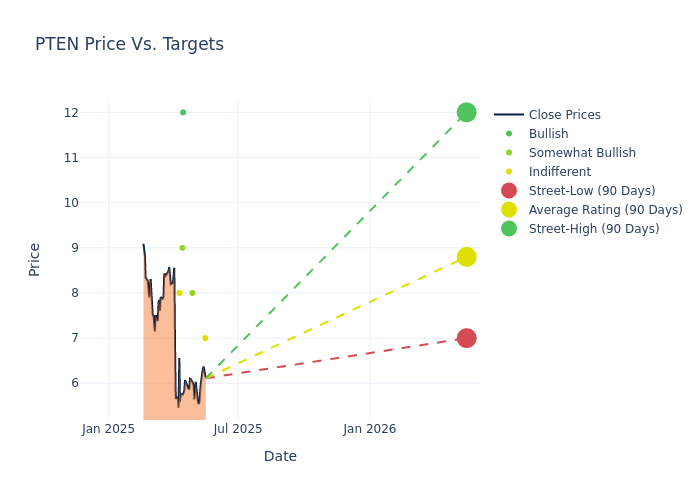The Analyst Verdict: Patterson-UTI Energy In The Eyes Of 6 Experts
6 analysts have expressed a variety of opinions on Patterson-UTI Energy (NASDAQ:PTEN) over the past quarter, offering a diverse set of opinions from bullish to bearish.
The table below summarizes their recent ratings, showcasing the evolving sentiments within the past 30 days and comparing them to the preceding months.
| Bullish | Somewhat Bullish | Indifferent | Somewhat Bearish | Bearish | |
|---|---|---|---|---|---|
| Total Ratings | 1 | 2 | 3 | 0 | 0 |
| Last 30D | 0 | 0 | 1 | 0 | 0 |
| 1M Ago | 0 | 1 | 0 | 0 | 0 |
| 2M Ago | 1 | 1 | 2 | 0 | 0 |
| 3M Ago | 0 | 0 | 0 | 0 | 0 |
Analysts have recently evaluated Patterson-UTI Energy and provided 12-month price targets. The average target is $8.83, accompanied by a high estimate of $12.00 and a low estimate of $7.00. This current average has decreased by 17.24% from the previous average price target of $10.67.

Understanding Analyst Ratings: A Comprehensive Breakdown
The analysis of recent analyst actions sheds light on the perception of Patterson-UTI Energy by financial experts. The following summary presents key analysts, their recent evaluations, and adjustments to ratings and price targets.
| Analyst | Analyst Firm | Action Taken | Rating | Current Price Target | Prior Price Target |
|---|---|---|---|---|---|
| Daniel Kutz | Morgan Stanley | Lowers | Equal-Weight | $7.00 | $9.00 |
| David Anderson | Barclays | Lowers | Overweight | $8.00 | $11.00 |
| Stephen Gengaro | Stifel | Lowers | Buy | $12.00 | $13.00 |
| Charles Minervino | Susquehanna | Lowers | Positive | $9.00 | $10.00 |
| Ati Modak | Goldman Sachs | Lowers | Neutral | $8.00 | $11.00 |
| Daniel Kutz | Morgan Stanley | Lowers | Equal-Weight | $9.00 | $10.00 |
Key Insights:
- Action Taken: Responding to changing market dynamics and company performance, analysts update their recommendations. Whether they 'Maintain', 'Raise', or 'Lower' their stance, it signifies their response to recent developments related to Patterson-UTI Energy. This offers insight into analysts' perspectives on the current state of the company.
- Rating: Offering a comprehensive view, analysts assess stocks qualitatively, spanning from 'Outperform' to 'Underperform'. These ratings convey expectations for the relative performance of Patterson-UTI Energy compared to the broader market.
- Price Targets: Gaining insights, analysts provide estimates for the future value of Patterson-UTI Energy's stock. This comparison reveals trends in analysts' expectations over time.
Navigating through these analyst evaluations alongside other financial indicators can contribute to a holistic understanding of Patterson-UTI Energy's market standing. Stay informed and make data-driven decisions with our Ratings Table.
Stay up to date on Patterson-UTI Energy analyst ratings.
Discovering Patterson-UTI Energy: A Closer Look
Patterson-UTI Energy Inc is one of the substantial land rig drilling contractors in the United States. Its 2023 merger with NexTier greatly expanded its pressure pumping operations, as well, and the firm now controls nearly 20% of the North American market for drilling and completions services. The company operates under three reportable business segments: (i) drilling services, (ii) completion services, and (iii) drilling products. It also provides directional drilling services and tool rental services in united states onshore oil and gas basins.
Patterson-UTI Energy's Economic Impact: An Analysis
Market Capitalization Analysis: The company's market capitalization is above the industry average, indicating that it is relatively larger in size compared to peers. This may suggest a higher level of investor confidence and market recognition.
Negative Revenue Trend: Examining Patterson-UTI Energy's financials over 3M reveals challenges. As of 31 March, 2025, the company experienced a decline of approximately -15.22% in revenue growth, reflecting a decrease in top-line earnings. When compared to others in the Energy sector, the company faces challenges, achieving a growth rate lower than the average among peers.
Net Margin: Patterson-UTI Energy's net margin is below industry standards, pointing towards difficulties in achieving strong profitability. With a net margin of 0.08%, the company may encounter challenges in effective cost control.
Return on Equity (ROE): Patterson-UTI Energy's ROE falls below industry averages, indicating challenges in efficiently using equity capital. With an ROE of 0.03%, the company may face hurdles in generating optimal returns for shareholders.
Return on Assets (ROA): Patterson-UTI Energy's ROA is below industry standards, pointing towards difficulties in efficiently utilizing assets. With an ROA of 0.02%, the company may encounter challenges in delivering satisfactory returns from its assets.
Debt Management: The company maintains a balanced debt approach with a debt-to-equity ratio below industry norms, standing at 0.38.
How Are Analyst Ratings Determined?
Ratings come from analysts, or specialists within banking and financial systems that report for specific stocks or defined sectors (typically once per quarter for each stock). Analysts usually derive their information from company conference calls and meetings, financial statements, and conversations with important insiders to reach their decisions.
Some analysts publish their predictions for metrics such as growth estimates, earnings, and revenue to provide additional guidance with their ratings. When using analyst ratings, it is important to keep in mind that stock and sector analysts are also human and are only offering their opinions to investors.
Which Stocks Are Analysts Recommending Now?
Benzinga Edge gives you instant access to all major analyst upgrades, downgrades, and price targets. Sort by accuracy, upside potential, and more. Click here to stay ahead of the market.
This article was generated by Benzinga's automated content engine and reviewed by an editor.